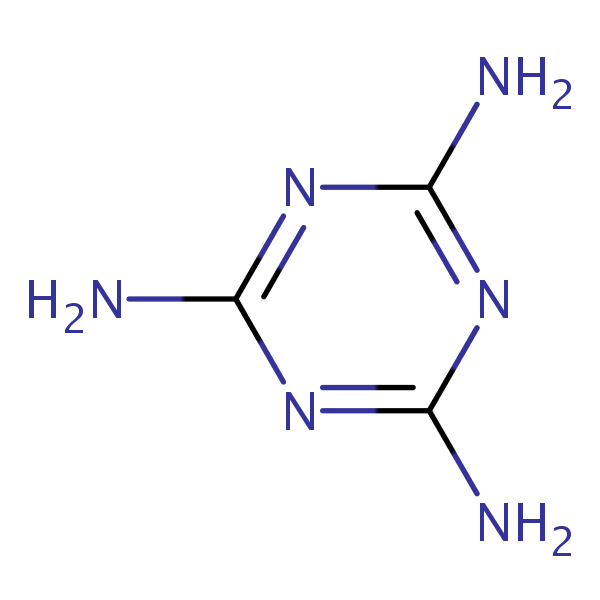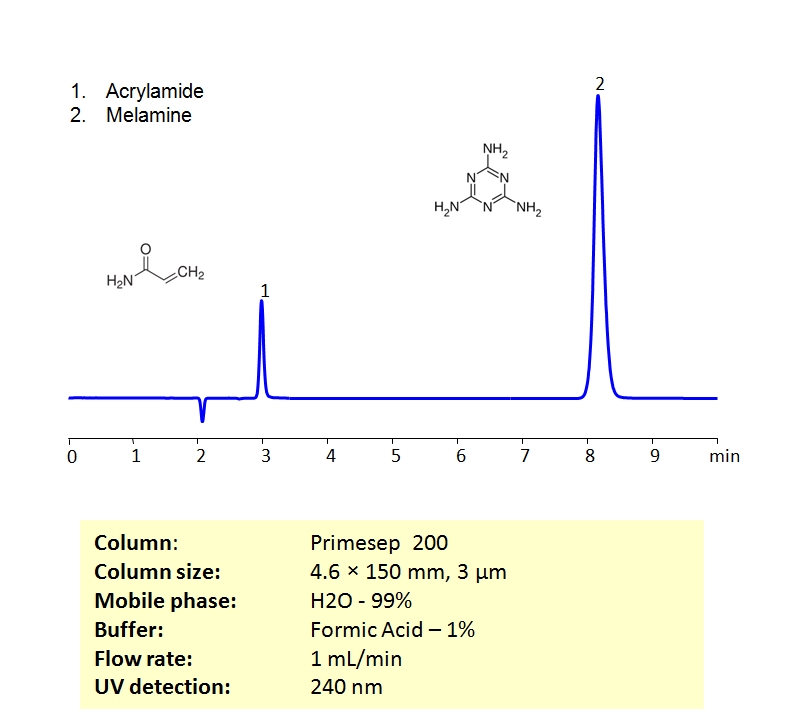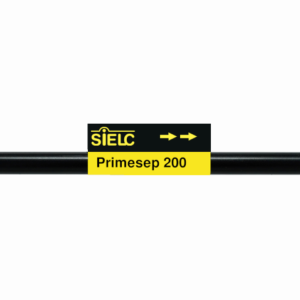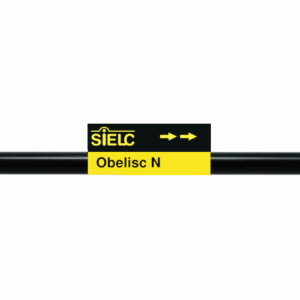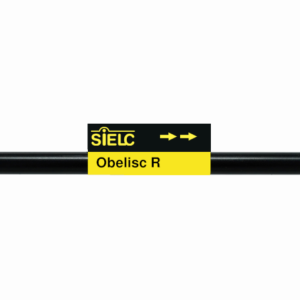| CAS Number | 108-78-1 |
|---|---|
| Molecular Formula | C3H6N6 |
| Molecular Weight | 126.124 |
| InChI Key | JDSHMPZPIAZGSV-UHFFFAOYSA-N |
| LogP | -1.37 |
| Synonyms |
|
Applications:
HPLC Separation of Acrylamide and Melamine on Primesep 200 Column
September 4, 2020
Melamine is a nitrogen-based organic compound that was first synthesized by the German chemist Justus von Liebig in 1834. Melamine is a decorative coating that is resistant to water and mechanical damage.
Melamine is used for:
- lamination of particle boards and plywood;
- manufacture of paints and varnishes;
- production of decorative paper-laminated plastics and plastics;
- manufacture of dishes.
We were able to separate Melamine from Acrylamide in HPLC on Primesep 200 column using a mobile phase of water with Formic Acid buffer. This separation can be monitored with UV, ELSD, CAD detection techniques.
| Column | Primesep 200, 4.6×150 mm, 3 µm, 100A |
| Mobile Phase | H2O – 99% |
| Buffer | Formic Acid – 1% |
| Flow Rate | 1.0 ml/min |
| Detection | UV 240 nm |
| Class of Compounds | Amide, Amine |
| Analyzing Compounds | Acrylamide, Melamine |
Application Column
Primesep 200
The Primesep family of mixed-mode columns offers a wide variety of stationary phases, boasting unprecedented selectivity in the separation of a broad array of chemical compounds across multiple applications. Corresponding Primesep guard columns, available with all stationary phases, do not require holders. SIELC provides a method development service available to all customers. Inquire about our specially-tailored custom LC-phases for specific separations.
Select optionsMelamine

Simultaneous Separation of Melamine and Cyanuric Acid
July 8, 2011
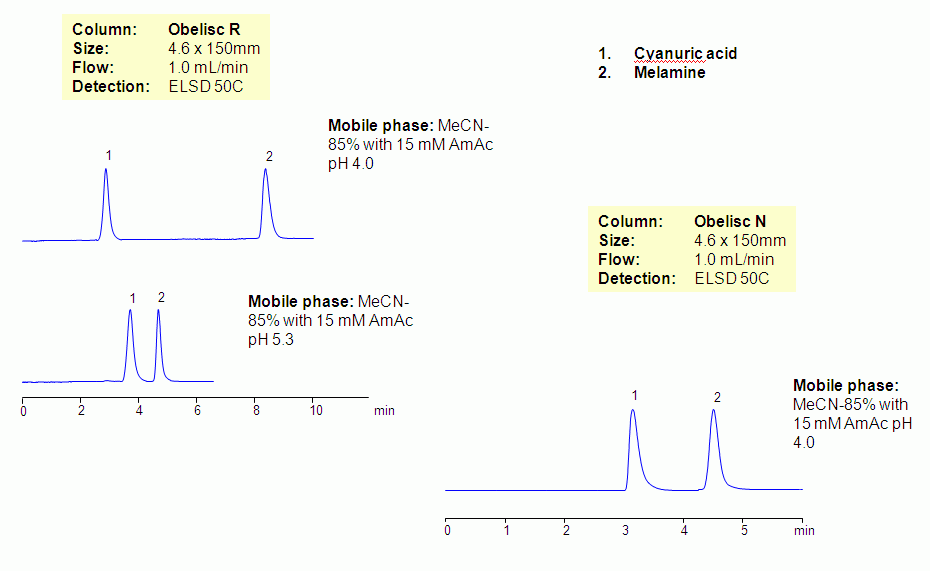
Melamine is an organic basic compound that is derived from cyanamide. It contains 66% nitrogen by mass. Addition of melamine is used to increase protein count in milk products. Cyanuric acid is a trimer of cyanic acid. Melamine and cyanuric acid can form a insoluble complex. Both compounds has been linked as additives to modify nitrogen count in products. Cyanuric acid is a slightly acidic hydrophilic compound, while melamine is a basic hydrophilic compound. Both compounds were separated on Obelisc R reversed-phase ion-exchange column with LC/Ms compatible mobile phase. Method can be used for generic analysis of basic and acidic compounds with LC/MS compatible conditions.
| Column | Obelisc N, 4,6×150 mm, 5 µm, 100A |
| Mobile Phase | MeCN |
| Buffer | AmAc |
| Flow Rate | 1.0 ml/min |
| Detection | ELSD 50C |
<
| Class of Compounds |
Acid, Hydrophobic, Ionizable |
| Analyzing Compounds | Melamine, Cyanuric Acid |
Application Column
Obelisc N
SIELC has developed the Obelisc™ columns, which are mixed-mode and utilize Liquid Separation Cell technology (LiSC™). These cost-effective columns are the first of their kind to be commercially available and can replace multiple HPLC columns, including reversed-phase (RP), AQ-type reversed-phase, polar-embedded group RP columns, normal-phase, cation-exchange, anion-exchange, ion-exclusion, and HILIC (Hydrophilic Interaction Liquid Chromatography) columns. By controlling just three orthogonal method parameters - buffer concentration, buffer pH, and organic modifier concentration - users can adjust the column properties with pinpoint precision to separate complex mixtures.
Select optionsObelisc R
SIELC has developed the Obelisc™ columns, which are mixed-mode and utilize Liquid Separation Cell technology (LiSC™). These cost-effective columns are the first of their kind to be commercially available and can replace multiple HPLC columns, including reversed-phase (RP), AQ-type reversed-phase, polar-embedded group RP columns, normal-phase, cation-exchange, anion-exchange, ion-exclusion, and HILIC (Hydrophilic Interaction Liquid Chromatography) columns. By controlling just three orthogonal method parameters - buffer concentration, buffer pH, and organic modifier concentration - users can adjust the column properties with pinpoint precision to separate complex mixtures.
Select optionsMelamine

HPLC Application for Determination of Melamine in Baby Formula
September 24, 2010
HPLC Method for Analysis of Melamine on Primesep 200 by SIELC Technologies
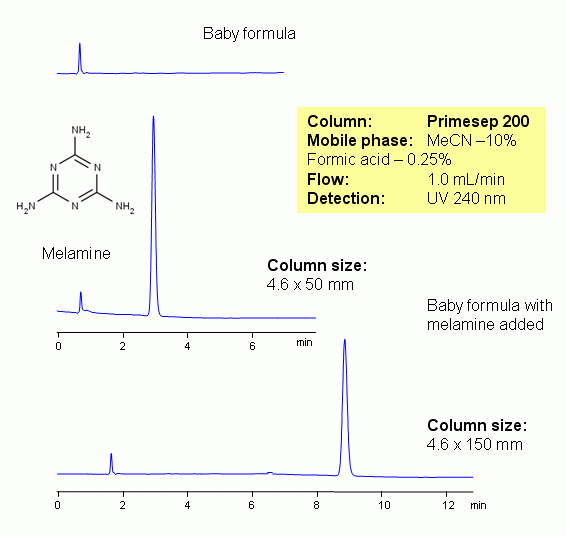
Melamine (1,3,5-triazine-2,4,6-triamine) is an organic base with pKa of 5. It is only slightly soluble in water. Melamine is a trimer of cyanamide. Melamine is a metabolite of pesticide cyromazine. Cyromazine is converted to melamine in plants. Melamine is used in production of plastics. In 2007 it was determined that melamine caused hundreds of pet deaths due to pet food contamination. Prior to these reports, melamine had been regarded as non-toxic or minimally toxic. However, because of the presence of the melamine in wheat gluten added to mass-produced dog and cat foods, it is the most likely cause. There is some data proving that melamine and cyanuric acid form a complex that show much higher toxicity.
It was found recently that melamine was added to various products (including milk formulas) to artificially inflate the reading for protein levels. Formula milk has not, until now, been tested for melamine, because regulators did not suspect this ingredient might be added. Indeed, it is this high nitrogen level – 66% nitrogen by mass – in melamine that gives it the analytical characteristics of protein molecules. A simple and fast HPLC method for determination of melamine is developed. Melamine is well retained on short (50 mm) Primesep columns. The retention is attributed to reverse phase and cation-exchange mechanism. Method uses acetonitrile-water based mobile phase with formic acid as an acidic modifier and Primesep 200 column. Method can be used in determination of melamine in food, milk, baby formulas, pet food, and other products by HPLC by direct injection or with preliminary protein clean up by ACN precipitation and filtration. Both MS (mass spectroscopy) detection and UV (ultra violet) detection at 240 nm can be effectively used to quantitate the presence and amounts of melamine with this method.
High Performance Liquid Chromatography (HPLC) Method for Analysis of Melamine
| Column | Primesep 200, 4.6 x 150 mm, 5 µm, 100 A |
| Mobile Phase | MeCN – 10% |
| Buffer | Formic Acid – 0.25% |
| Flow Rate | 1.0 ml/min |
| Detection | UV 240nm |
| Class of Compounds | Hydrophobic, Ionizable |
| Analyzing Compounds | Melamine |
Application Column
Primesep 200
Column Diameter: 4.6 mm
Column Length: 150 mm
Particle Size: 5 µm
Pore Size: 100 A
UV Detection

